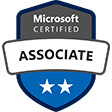Course Length: 4-Days
Course Overview
This course provides IT Security Professionals with the knowledge and skills needed to implement security controls, maintain an organization’s security posture, and identify and remediate security vulnerabilities. This course includes security for identity and access, platform protection, data and applications, and security operations.
Audience Profile
This course is for Azure Security Engineers who are planning to take the associated certification exam, or who are performing security tasks in their day-to-day job. This course would also be helpful to an engineer that wants to specialize in providing security for Azure-based digital platforms and play an integral role in protecting an organization's data.
At Course Completion
After completing this course, students will be able to:
- Implement enterprise governance strategies including role-based access control, Azure policies, and resource locks.
- Implement an Azure AD infrastructure including users, groups, and multi-factor authentication.
- Implement Azure AD Identity Protection including risk policies, conditional access, and access reviews.
- Implement Azure AD Privileged Identity Management including Azure AD roles and Azure resources.
- Implement Azure AD Connect including authentication methods and on-premises directory synchronization.
- Implement perimeter security strategies including Azure Firewall.
- Implement network security strategies including Network Security Groups and Application Security Groups.
- Implement host security strategies including endpoint protection, remote access management, update management, and disk encryption.
- Implement container security strategies including Azure Container Instances, Azure Container Registry, and Azure Kubernetes.
- Implement Azure Key Vault including certificates, keys, and secretes.
- Implement application security strategies including app registration, managed identities, and service endpoints.
- Implement storage security strategies including shared access signatures, blob retention policies, and Azure Files authentication.
- Implement database security strategies including authentication, data classification, dynamic data masking, and always encrypted.
- Implement Azure Monitor including connected sources, log analytics, and alerts.
- Implement Azure Security Center including policies, recommendations, and just in time virtual machine access.
- Implement Azure Sentinel including workbooks, incidents, and playbooks.
Prerequisites
Previous experience with cloud and on-prem core services (Network, Compute, Storage, etc.)
MS AZ 900 Microsoft Azure Fundamentals
Course Outline
Manage Identity and Access: This module covers Azure Active Directory, Azure Identity Protection, Enterprise Governance, Azure AD PIM, and Hybrid Identity.
- Azure Active Directory
- Azure Identity Protection
- Enterprise Governance
- Azure AD Privileged Identity Management
- Hybrid Identity
Labs:
- Role-Based Access Control
- Azure Policy
- Resource Manager Locks
- MFA, Conditional Access and AAD Identity Protection
- Azure AD Privileged Identity Management
- Implement Directory Synchronization
After completing this module, students will be able to:
- Implement enterprise governance strategies including role-based access control, Azure policies, and resource locks.
- Implement an Azure AD infrastructure including users, groups, and multi-factor authentication.
- Implement Azure AD Identity Protection including risk policies, conditional access, and access reviews.
- Implement Azure AD Privileged Identity Management including Azure AD roles and Azure resources.
- Implement Azure AD Connect including authentication methods and on-premises directory synchronization.
Implement Platform Protection: This module covers perimeter, network, host, and container security.
- Perimeter Security
- Network Security
- Host Security
- Container Security
Labs:
- Network Security Groups and Application Security Groups
- Azure Firewall
- Configuring and Securing ACR and AKS
After completing this module, students will be able to:
- Implement perimeter security strategies including Azure Firewall.
- Implement network security strategies including Network Security Groups and Application Security Groups.
- Implement host security strategies including endpoint protection, remote access management, update management, and disk encryption.
- Implement container security strategies including Azure Container Instances, Azure Container Registry, and Azure Kubernetes.
Secure Data and Applications: This module covers Azure Key Vault, application security, storage security, and SQL database security.
- Azure Key Vault
- Application Security
- Storage Security
- SQL Database Security
Labs:
- Key Vault (Implementing Secure Data by setting up Always Encrypted)
- Securing Azure SQL Database
- Service Endpoints and Securing Storage
After completing this module, students will be able to:
- Implement Azure Key Vault including certificates, keys, and secretes.
- Implement application security strategies including app registration, managed identities, and service endpoints.
- Implement storage security strategies including shared access signatures, blob retention policies, and Azure Files authentication.
- Implement database security strategies including authentication, data classification, dynamic data masking, and always encrypted.
Manage Security Operations: This module covers Azure Monitor, Azure Security Center, and Azure Sentinel.
- Azure Monitor
- Azure Security Center
- Azure Sentinel
Labs:
- Azure Monitor
- Azure Security Center
- Azure Sentinel
After completing this module, students will be able to:
- Implement Azure Monitor including connected sources, log analytics, and alerts.
- Implement Azure Security Center including policies, recommendations, and just in time virtual machine access.
- Implement Azure Sentinel including workbooks, incidents, and playbooks.
Certification

Microsoft Certified: Azure Security Engineer Associate
Exam AZ-500: Microsoft Azure Security Technologies
Schedule Your Exam with Vue.

